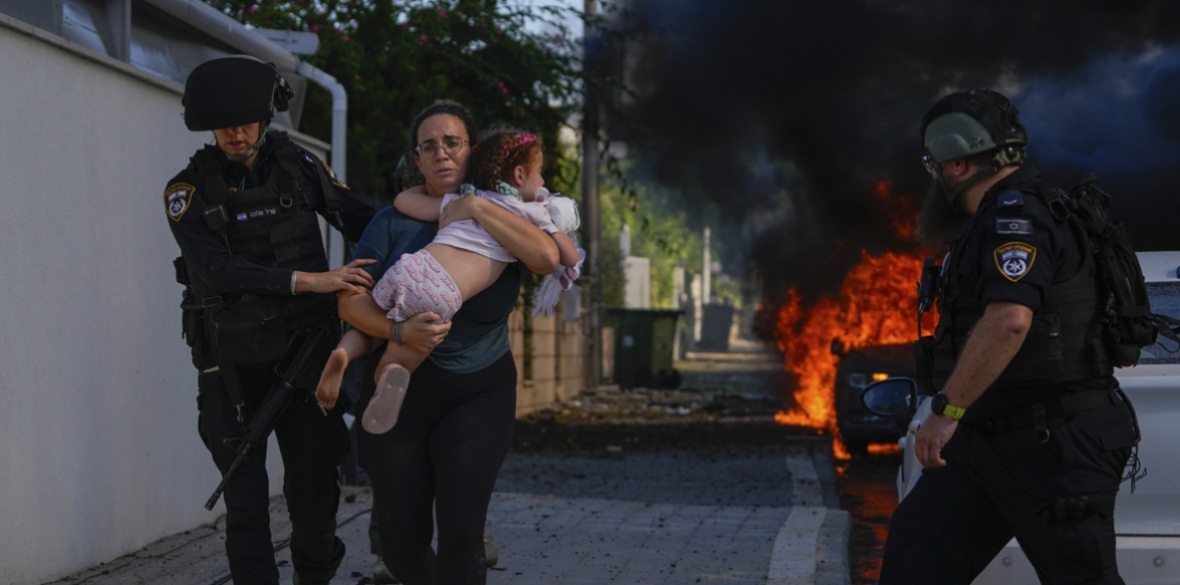The Palestinians broke through the border of Gaza—which Israel has maintained as an open-air prison

A Palestine solidarity protest in London last year. Another is planned on Monday night (Picture: Guy Smallman)
In the face of escalating violence from the Israeli state, Palestinian fighters launched resistance attacks on Israeli towns, cities and settlements on Saturday. And they have won huge military gains.
Israel’s prime minister, Binyamin Netanyahu, declared from the military headquarters in Tel Aviv, “Citizens of Israel, we are at war.”
Palestinian resistance group Hamas, said its attack followed the atrocities committed by the Israeli state “against Palestinian people and our holy sites like Al-Aqsa”. Hamas commander Mohammed Deif stated, “We’ve decided to say enough is enough. This is the day of the greatest battle to end the last occupation on Earth.”
The group launched rockets early in the morning from the Gaza Strip. Palestinian fighters also dispatched armed drones, fighters on motorbikes and paragliders across the strip’s border, storming Israeli military bases and checkpoints. At around 10am on Saturday Hamas fighters had taken over 21 military bases, holding Israeli soldiers as prisoners of war.
And in the city of Sderot, Palestinian fighters took over a police station and set it on fire. Palestinians also bulldozed a fence which separates the Gaza Strip from Israel.
By midday, Israeli news channels had to admit that Palestinian resistance fighters effectively controlled all illegal Israeli settlements at the Gaza border. Palestinian fighters took over and held the headquarters of the Israeli occupation’s Southern Command.
“This is definitely a pivotal moment and in any scenario Israel is coming out of it very badly,” said Avi Melamed, an Israeli intelligence analyst.
Israeli planes began bombing in several locations across Gaza. The Palestinian Health Ministry said at least 198 people were killed and more than 1,610 were wounded by Israeli strikes.
Israeli officials said rocket attacks and Palestinian gunfire killed at least 40 Israelis. The attacks caught the Israeli state by surprise. But it should be no surprise there is resistance. Ever since the formation of the state through ethnic cleansing, expulsion and murder in 1948, Israel carried out apartheid policies and worke4d alongside imperialism
Following the attack Israel’s imperialist allies quickly asserted their support, whatever the human cost. Pentagon chief Lloyd Austin promised that the United States would provide Israel with “what it needs to defend itself”.
Tory foreign secretary James Cleverly said that Britain “will always support Israel’s right to defend itself”. Defending a state based on systematic Palestinian oppression is itself an act of aggression.
Pernicious plans of Israel’s far right
As journalist Tony Karon tweeted, “The racist contempt for Palestinian life that forms the core of US policy on Israel offers no path to liberty, dignity and justice for Palestinians, who are systematically brutalised every day. And then the US calls their resistance ‘unprovoked’.”
Repeatedly the Israeli state has attacked and slaughtered Palestinians living in refugee camps in Jenin. An assault on Jenin last week was the biggest Israeli raid in the occupied West Bank in two decades. It killed 12 Palestinians, injured 140 and forced thousands to flee
Netanyahu’s government, which has faced domestic opposition over how best to maintain the state, has absorbed far right figures such as security minister Itamar Ben-Gvir. He demanded “a military operation to demolish buildings, eliminate terrorists, not one or two, but tens and hundreds, and if necessary even thousands.”
The Palestinian people have every right to respond in any way they choose to the violence that the Israeli state metes out to them every day.
In 2021 a historic uprising across Palestine mounted a direct challenge to Israel’s regime. For the first time in decades Palestinians joined across Israel’s borders in mass resistance from below—raising the prospect of a united Palestine freed through struggle.
The revolt included a powerful strike by Palestinian workers. The occupation believed it had subsequently regained full control. But again the fightback has burst through.
A key issue now is whether workers and the poor in the surrounding area themselves revolt against their reactionary rulers and aid the Palestinian uprising.
Israel: Palestinian ambassador to the UK refuses to condemn Hamas attacks
Sky News‘We’re rewriting history, our fighters took the initiative’—Palestinian speaks out
Palestinians struck a huge blow against Israeli settler colonialism on Saturday. A Palestinian living near Jerusalem spoke to Socialist Worker about the significance of the unprecedented attack from Gaza

Palestinians need a wave of solidarity with their national liberation struggle (Picture: Guy Smallman)
All of us are proud. Today was a rewriting of history—our history. I can hear the bombing now. In Tel Aviv, Gaza and everywhere is all under fire. We are watching what we thought would never, in our lifetime, happen.
There was information provided to the Palestinian resistance that Israel was set to do something following their holy day today.
But I think that for the first time in history—well at least since after 1973—our fighters have taken the initiative. It proved and showed how weak Israel’s apartheid regime is.
What Israel has built for more than 30 years, with the border walls and fences and cameras in the skies, fell apart. And a few fighters were able to invade.
It all collapsed within six or seven minutes. The fighters managed to spread out across Gaza and occupy Israeli settlements and different military camps.
Hundreds of Palestinian civilians ran through the fences, which were destroyed by the resistance. I feel that for the first time, every Palestinian worldwide will feel proud about what we achieved.
Gaza is now under fire. Israel destroyed a huge tower. We don’t know how many people were killed, but the tower must have housed hundreds of families.
I hope this is a good lesson for Israeli society to think of others, not just themselves. The two million people that are living in the Gaza Strip have been under complete siege since 2006. What do the Israelis or the world expect from them?
I saw how the Israeli military machine was confused and afraid about what’s coming. They were furious about losing control.
I believe that what came before 7 October 2023 is history—and what’s coming after will ensure that things are never the same again.
SUNDAY, OCTOBER 8, 2023

Police officers evacuate a woman and a child from an area hit by a rocket fired from the Gaza Strip, in Ashkelon, southern Israel, October 7, 2023
HAMAS has shocked the world with both the scale and success of its attack on Israeli territory over the weekend — and British politicians have been quick to offer Israel their full support.
Hundreds of Israelis have been killed or kidnapped and, while hundreds of Palestinians have already been killed in vengeful air raids on Gaza, the Israeli military was still struggling to reassert control within its borders last night.
Benjamin Netanyahu does not downplay the disaster, warning the country is on the brink of “a long war.” If that is the case, as demonstrators marching on the Labour conference in Liverpool today warned, it will entail many thousands of deaths.
But for millions of Palestinians that “long war” didn’t begin on Saturday. Keir Starmer portrays Hamas’s action as an unjustifiable act of terror, and talks of it undermining “any chance for future peace in the region.”
His rhetoric is familiar: political leaders across western Europe and the United States respond in this way every time Israel’s occupation of Palestinian land and blockade of Gaza flare into open conflict. But this default alignment with Israel is partly responsible for the scenes now unfolding.
Netanyahu heads the most right-wing government in Israel’s history. It is labelled fascist even by some opposition parties in Israel itself, including the Communist Party. Some of its own ministers agree: its Finance Minister Bezalel Smotrich describes himself as a “fascist homophobe.”
It builds on a legacy of ever more extreme assaults on Palestinian rights over recent history. Its infamous Nation State Law of 2018 formalised the subordinate status of the one-fifth of its citizens who make up the “Israeli Arabs” (a term which is itself used because Israel declines to recognise Palestine as a nation or Palestinians as a people).
This, together with the systemic oppression of Palestinians in their own illegally occupied or besieged lands, has prompted the most prominent liberal human rights organisations in the world, Amnesty International and Human Rights Watch, to agree that Israel is an apartheid state.
Amnesty assessed that the routine “massive seizures of Palestinian land and property, unlawful killings, forcible transfer, drastic movement restrictions, and the denial of nationality and citizenship to Palestinians” amounted to a single overarching system of repression “which amounts to apartheid under international law.”
That term is banned from the Labour conference meeting in Liverpool. The Palestine Solidarity Campaign was barred from using it when advertising its fringe meeting, and the term was deleted from the meeting’s listing in the conference brochure.
Yet not only has Israel operated such a system for years, it is getting worse. Hundreds of Palestinians had been killed in 2023 before Hamas launched its assault on Saturday; the United Nations already deemed it the deadliest year for Palestinians since 2006.
Netanyahu’s bid to overhaul Israel’s judiciary and give an increasingly far-right Knesset the ability to overrule the Supreme Court will only accelerate the theft and colonisation of Palestinian land.
His racist thug of a Security Minister Itamar Ben-Gvir has been promised a new “national guard” to command that will terrorise Palestinian communities: even Benny Gantz, a recent Israeli defence minister and deputy prime minister, warns that this will be a private army and a law unto itself.
It is this savage regime that Britain’s government wishes to defend by banning the Boycott, Divestment and Sanctions movement. That Starmer wants to sanitise by censoring discussion of its crimes at Labour conference.
Talk of a “peace process” has long been a sick joke when Israel continues to colonise land, ethnically cleanse Jerusalem and jail and kill Palestinians on a daily basis.
The complicity of Israel’s Western backers allows it to do so. It is this ongoing nightmare which Palestinians continue to resist: and until Israel’s allies force it to engage with the Palestinians’ right to an independent state, the violence will go on.
David Cronin

Britain’s James Cleverly (left) – pictured here with Israel’s Benjamin Netanyahu – is among many Western politicians who has condemned Palestinians for resisting a military occupation. (via Twitter)
I learned the word “condemn” at an early age. It was used constantly on Irish news bulletins in the 1980s.
In theory, “condemn” is a verb that may be applied to any act that triggers feelings of strong disapproval. In practice, it is used more to oppose violence by the oppressed than the oppression which causes that violence.
The partition of both Ireland and Palestine was ushered in by Britain.
As well as carving up both countries, Britain pursued similar policies in both situations.
People of one ethnicity and religion were encouraged to discriminate – systematically – against people of another. In both cases, the discrimination took place in a context of settler-colonialism.
With that history having consequences that endures to this day, Britain ought to be condemned routinely by everyone who opposes injustice.
If the media actually did their job and exposed Britain’s crimes, then comments made over the past few days by James Cleverly, the foreign secretary, would have zero credibility.
According to Cleverly, Britain “unequivocally condemns the horrific attacks by Hamas on Israeli civilians.” Britain, he added, “will always support Israel’s right to defend itself.”
The “attacks” to which he alluded were actually a response to the brutal subjugation of the Palestinian people. Britain set that subjugation in motion as far back as 1917, when Arthur James Balfour, one of Cleverly’s predecessors as foreign secretary, signed his infamous declaration supporting the Zionist movement and its colonization project.
Right to defend?
All talk about Israel’s “right to defend itself” is utter bollocks – if I may use a term with which Cleverly is undoubtedly familiar.
Israel – which has subjected Gaza to a total blockade since 2007 and bombarded its people with frightening regularity – does not have the right to defend itself. The truth is that Palestinains have a right – recognized by the United Nations General Assembly – to defend themselves against Israel’s military occupation and all its attendant aggression.
Ursula von der Leyen, president of the European Commission, tried to sound even angrier than Cleverly. She fulminated against “the attack carried out by Hamas terrorists,” labeling it “terrorism in its most despicable form.”
Needless to say, von der Leyen had nothing to say about how the European Union mollycoddles Israel – actively seeking closer relations with that state, even as its government assumes an overtly fascist character. Von der Leyen herself has implicitly endorsed the ethnic cleansing on which Israel was founded in 1948 by praising the Zionist dream of making “the desert bloom.”
With that record, it is not surprising that von der Leyen is selective in her outrage.
Ariel Kallner, a member of the Knesset (Israel’s parliament), reacted to the Hamas-led operation by calling for a new Nakba.
The Nakba – Arabic for catastrophe – involved the expulsion of approximately 800,000 Palestinians from their homes. Kallner advocated a “Nakba that will overshadow the Nakba of ‘48,” contending “there is no other way.”Kallner chairs a committee in the Knesset handling Israel’s relations with the EU. Yet his call did not elicit any comment from von der Leyen or other senior players in the Brussels bureaucracy.
Von der Leyen’s reticence is consistent. If she gave her blessing to the first Nakba, then why would she have any qualms about a new one?
Vile anti-Semitism
Her fellow German Katarina von Schnurbein – the EU’s coordinator for combating anti-Semitism – has expressed “full solidarity with Israel and the Jewish people” since the Hamas-led operation.In circulating that message, von Schnurbein has committed an anti-Semitic act.
She tirelessly promotes the definition and accompanying “examples” of anti-Semitism adopted by the International Holocaust Remembrance Alliance – a lobby group made up of Israel and governments that support it.
One such example is “holding Jews collectively for actions of the state of Israel.”
By expressing solidarity in that way, von Schnurbein is claiming that Israel is now bombing residential towers in Gaza on behalf of Jews the world over. She should be formally censured for that vile anti-Semitism but we can be sure that she won’t be.
While the Hamas-led operation took everyone by surprise, the response from the US was entirely predictable. Joe Biden, the president, claimed that “Israel has the right to defend itself – full stop.”With that “full stop,” it was clear that he was not going to start shedding tears for all the Palestinians now being killed with the US-made weapons in Israel’s arsenal.
Bernie Sanders – the senator who has previously argued that “Palestinian lives matter” – is not genuinely committed to Palestinian freedom.
Like so many other politicians, he rushed to condemn the Hamas-led operation, without saying a word about Israel’s relentless killings of Palestinians that this year had already exceeded last year’s dreadful total even before the most recent events.The ritual condemnations I heard growing up in Ireland did not save a single life. It was only when a concerted effort was made to address the underlying injustices that a peace – albeit a flawed and fragile one – could be established.
The ritual condemnations of Palestinian resistance fighters over recent days will not save one life, either.
By flanking the condemnations with deceptive garbage about Israel’s “right to defend itself,” the West’s politicians are siding with the oppressor. They are giving Israel carte blanche to keep killing Palestinians.
Their chorus of condemnation deserves nothing but contempt.


















